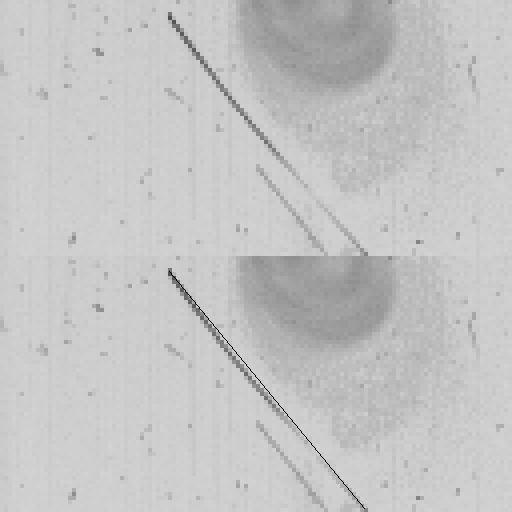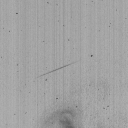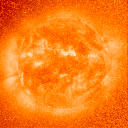
Well, from the point of view of academic family, we X-ray astronomers spring from research groups specializing in cosmic rays. Not only did these remarkable particles (the discovery of which led to an early Nobel prize) serve as a laboratory for basic physics, they're also astronomical. No doubt the linkage of particle physics and cosmology has deep roots! In fact X-rays are really photons, the bread and butter of regular astronomers, and not material particles, but some of the experimental techniques remind one more of high-energy physics.
The CCD detector of SXT recorded the track of a high-energy charged particle. It does this frequently, even though particles are few and the camera is in fact shielded from them in any case. Yohkoh flies well below most of the Van Allen belts, and is shielded by the Earth's magnetic field from all but the most energetic primary cosmic rays. But here is what we saw recently:

The above figure shows a curious cosmic-ray track observed by Yohkoh SXT at 15:17:34 UT, July 25, 2000. The copy at the bottom has a straight line fitted roughly to the end pixels. The curved features at the top are coronal magnetic loops. There are a couple of peculiarities. First, the track is slightly curved - at an eyeball estimate, about 1.4 pixels at maximum. The SXT pixels are 18.28 microns, so this is about 25 microns of curvature. Second, the track is brightest at the two endpoints. The length of the track is about 1.4 mm.
Following the discovery of this track, the SXT group and friends have been exchanging e-mail about what it represents. All no doubt agree that it is not important science, but just interestingly unusual. Here are some of the comments that have resulted:
Comments:
First of all (theoreticall!) how much exposure does the CCD have? It turns out that the CCD contains a volume of about .006 cm^3 of Si, and that it has been exposed for tracks perhaps for a total of 5 million seconds since launch. Spreading the CCD's 6 microliters out into a layer roughly as thick as the range of a cosmic ray (say 50 gm/cm^2), one can estimate a paltry exposure of some 600 cm^2-sr-sec for the whole nine years. No wonder people don't use CCDs as primary detectors for high-energy cosmic rays! At this exposure we might expect to see only about one "star" interaction event (ie, a true nuclear reaction - would be spectacular, no doubt) in the whole data set.
Instead, what we almost certainly see here is a low-energy secondary particle produced by scattering within the Si of a proton (say, 100 MeV) from the Van Allen belt - from the nice map of the Yohkoh orbit you'll see that Yohkoh was flying above Argentina at the time of the event, and this is as close as the orbit comes to the magnetosphere (it turns out).
A quick search for similar events turned up these beauties:

|

|
On the left, a nice straight track, with the faint-bright-faint character expected of a particle arcing through the CCD tangentially; on the right, a champion long track with a straight line fitted. This beauty is more than 6 mm long - it vanishes at the top of the CCD. The left image is "half resolution", 2x2 pixel sums; the right image is "quarter resolution", 4x4 sums. Both tracks above are a lot fainter than the curved track. This means that it had a higher density of ionization - hmmm. If anybody would like to try to estimate the particle Z (is it perhaps one of the CCD's own Si atoms, or a spallation product from one of them, or just a humdrum proton?) ask the undersigned and I'll provide an estimate of charge per unit length.
As a postscript to this nugget, but it really deserves a full writeup of its own, we show you the "snowstorm" detected by SOHO following the X-class flare of July 14, 2000. The sequence of events is as follows: a huge flare erupts on the solar disk, spotted by various observers; the CME resulting from this then appears in the SOHO coronagraphs; en route to the Earth or wherever, the shock wave caused by the CME accelerates high-energy particles; these particles zip right over to SOHO and cause a cloud of streaks in their next set of images. Yohkoh is protected from these particles because of its low orbit, but the Lagrangian point is out there fully exposed, some 1% of the way from the Earth to the Sun. So, one image is worth a thousand words, but be careful - the link is 1 MB:

Sam Freeland provided this image, and noted at the same time that one or two long curved tracks are present (bottom; upper left). In fact there are many things to see, including what look like actual vertices (eg, at pixel coordinates [805, 444]).
August 2, 2000